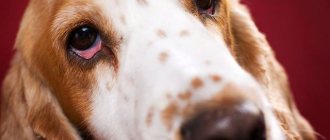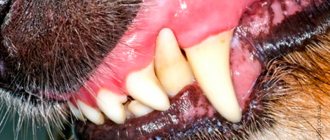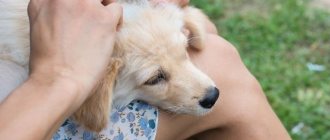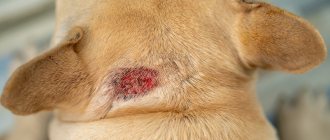In this article I will talk about conjunctivitis in dogs. I will give the main reasons for the development of the disease. I’ll tell you about the types of conjunctivitis in dogs and list their symptoms. I will show you how to treat the disease at home. I'll tell you what preventive measures need to be followed.
Causes of conjunctivitis in dogs
We can say that the disease is closely related to immunity deficiency. Pathogenic microorganisms enter the eye from the air, penetrate the conjunctiva and cause an inflammatory process if the body does not resist.
There are breeds that are at risk and prone to conjunctival inflammation. First of all, these are dogs with long hair: Yorkshire terriers, lapdogs, poodles, spaniels. The second group of animals are with large round eyes: Pekingese, Chihuahuas, pugs, bulldogs. Also, frequent inflammation of the mucous membrane is typical for dogs with an open lower eyelid: Alabai, Basset Hounds. And the last group is genetically predisposed dogs: Dobermans, Great Danes.
Other causes of conjunctivitis:
- Mechanical (ingress of sand, dust, small debris, eye injury, bruise);
- Contact with smoke, chemical vapors or liquid substances (detergents, shampoos, toothpastes);
- Dermatological problems affecting the skin of the eyelids;
- Burns, frostbite;
- Ingrown eyelashes;
- Fungal or viral infections;
- Metabolic disease;
- Allergic reaction to pollen or food;
- Vitamin deficiency;
- Constant hair getting into the eyes, causing excessive tearing;
- Age-related eye diseases.
What is the conjunctiva and how to determine its inflammation
The conjunctiva is the mucous membrane that covers the outer part of the eyeball and the back surface of the eyelid. This thin and transparent shell is necessary for:
- protection from pathogenic microorganisms and foreign bodies;
- wetting the eyes with tear fluid to prevent them from drying out;
- ensuring mobility of the eyeballs and eyelids.
With any disorders, including inflammatory processes, this important organ loses its functionality. The presence of pathology can be understood by changes in the appearance of the mucous membrane. Instead of pale pink, its shade changes to bright red, the smooth surface may become ulcerated, and the previously moderate humidity becomes higher than normal.
Types and symptoms of the disease with photos
First of all, the disease can be divided into 2 types: primary, when the cause of the problem lies on the surface (eye injury, sand ingress, etc.), secondary, when conjunctivitis develops due to infection (distemper, adenovirus, hepatitis).
The general classification divides conjunctivitis in dogs into 4 types. Each of them has its own causes, symptoms, course, treatment and complications.
Follicular conjunctivitis in dogs
A chronic breed disease, often found in dogs with drooping lower eyelids . It is characterized by inflammation of the third eyelid due to enlargement of the gland, the appearance of follicles (small bubbles with liquid). It is treated either with antibiotic ointments and drops, or with surgery.
Symptoms of follicular conjunctivitis:
- Itching, lacrimation, whitish or yellowish purulent discharge;
- Swelling of the eyelid and conjunctiva, redness;
- Dried crusts on the surface of the eyelids and eyelashes;
- Pain, swelling of the eye, closure of the palpebral fissure;
- Photophobia;
- Increased body temperature.
Long-term untreated follicular conjunctivitis can lead to blindness.
Catarrhal
This type of conjunctivitis is the mildest and is often caused by eye injury or an allergic reaction. Its danger lies in the fact that without comprehensive treatment, a mild form develops into a chronic form with regular exacerbations. Symptoms of catarrhal conjunctivitis:
- Redness of the mucous membrane and eyeball (after injury, burst blood vessels may appear);
- Swelling of the eyelid;
- Mucous clear or whitish discharge;
- Profuse lacrimation;
- Symptoms of allergic reactions may occur.
Purulent conjunctivitis
Purulent discharge often indicates the appearance of a pathogenic microorganism . This type of conjunctivitis appears as a symptom of infection with canine distemper, an adenovirus. In this case, the pet will be contagious both to its fellows and to humans. But sometimes suppuration occurs due to blepharitis, trichiasis, keratitis (inflammation of the cornea of the eye). The most “harmless” reasons are ingrown eyelashes and large eye openings.
Symptoms of the disease:
- Purulent yellow or greenish discharge, accumulations in the corners of the eyes;
- There may be an unpleasant odor;
- Increased body temperature;
- Redness of the eyelids;
- Photophobia.
This form of conjunctivitis requires veterinary intervention to determine the cause. If the problem lies in an infectious infection of the body, then the treatment regimen will be built around destroying the virus and restoring the immune system.
A rare form - dry keratoconjunctivitis appears due to insufficient tear production. Often, the disease is a consequence of untreated keratitis or conjunctivitis. Manifested by symptoms: clouding of the cornea, dry mucous membrane, yellowish viscous discharge.
Purulent conjunctivitis in puppies
A separate type of conjunctivitis, which is also called physiological ankyloblepharon. Appears in puppies that have not yet opened their eyes. The main reason is an infectious disease in the female who gave birth or intrauterine pathologies. Characteristic symptoms are swelling of the closed eyes and accumulation of whitish discharge in the corners.
The problem requires special treatment:
- Opening the eye surgically (less often manually);
- Cleansing from pus with herbal decoctions (chamomile);
- Lubrication with antibacterial ointment (veterinarian consultation required).
Allergic
This type of conjunctivitis occurs when an allergen (dust, pollen) gets into the mucous membrane or cornea of the eye. Symptoms differ from the typical form: clear discharge, severe redness, tearfulness. In addition, other symptoms of allergic irritation may be observed: sneezing, itching, rashes, hair loss.
The dog may scratch itself against furniture, scratch its sore eye with its paw, or squint. Rarely lethargy, lack of appetite, and depression appear.
Signs
Pathological symptoms develop dynamically, replace each other, and depend on the form of the disease. Catarrhal conjunctivitis is characterized by the following symptoms:
- the mucous membrane turns red;
- eyelids swell;
- lacrimation develops;
- At first, a clear liquid is released from the eyes, which gradually becomes cloudy and acquires a mucous consistency.
Conjunctivitis becomes purulent when catarrhal inflammation is not treated or an underlying disease occurs. The following pathological changes develop:
- discharge from the eyes turns yellow-greenish, which indicates the proliferation of pathogenic microflora;
- exudate accumulates on the edges of the eyelids, sticking them together;
- the inflamed organs of vision cause an unpleasant odor;
- exudate particles oxidize, turn brown, dry out, and crusts form;
- severe itching appears, the pet rubs its eyes with its paws;
- body temperature rises;
- Photophobia arises, it hurts the dog to look, it hides from bright light.
The follicular form of the disease develops from a purulent form or occurs as an allergic response to an irritant. Lymph nodes hypertrophy, the third eyelid becomes noticeable.
Keratoconjunctivitis or dry eye syndrome occurs as a result of a prolonged inflammatory process, unsuccessful surgery, side effects of medications or genetic predisposition. The anomaly occurs in English bulldogs, cocker spaniels, Yorkshire terriers, and other decorative breed dogs. The conjunctival cavity is filled with a thick yellowish-green viscous exudate. The cornea dries out. Muddy black spots form on it, which appear along the edges and gradually cover the central areas. The animal loses its sight.
Watch the video
Treating conjunctivitis in dogs at home
If the owner is encountering a problem for the first time, it is better to show the pet to a veterinarian and conduct a diagnosis to find the causes of the development of the disease. To do this, they take a blood and urine test, and examine the nature and type of discharge.
If you can’t get to the clinic in the near future, you need to provide first aid to your pet, relieve swelling and pain. At home, you can help your pet by washing and applying ointment:
- 1 tablet of furatsilin per 100 ml of water, soak a cotton swab in the solution and rinse the areas of suppuration well, each eye is treated separately (it is better to divide the liquid into 2 parts and use different swabs), you need to move from the outer corner to the inner, repeat the procedure 3-4 times in a day;
- In folk medicine, instead of furatsilin, they use strong brewed black tea, chamomile infusion or eyebright decoction (10 g of herb per 100 ml of boiling water);
- If you have veterinary eye drops on hand, then the cleaned eyes should be instilled;
- If the animal is allergic, the owner observes itching, skin rashes and other symptoms of allergic irritation, it is necessary to give the dog an antihistamine (Suprastin, for example).
During the course of the disease, it is better to put a protective collar on the dog, limit the time of walks, and prohibit contact of the sick pet with healthy ones. It is important to monitor the quality of the animal’s diet, protect it from drafts, and ensure restful sleep.
Preventive measures
It is impossible to completely protect an animal from the disease, but with the right approach to its lifestyle, the risk of developing the disease can be significantly reduced. To do this, it is enough to be attentive to your pet: do not skip vaccinations, avoid hypothermia and monitor the dog’s movements.
You should not allow your pet to play in dangerous places where there are small branches, dust and sand, or let him into the kitchen while cooking. The animal must live in a clean environment and not have access to household chemicals and sharp objects that can injure the mucous membrane of the eye. If your dog is prone to allergies and inflammatory processes in the body, it is recommended to consult a veterinarian to prescribe a course of antihistamines.
With timely examination and the inclusion of vitamin supplements in the dog’s diet, the likelihood of conjunctivitis will significantly decrease, and the pet’s health will return to normal in many respects.
List of drugs for treatment (drops, ointments)
To cure a sore eye, you need to apply a regimen that includes antibacterial, anti-inflammatory, and antibiotic drugs. In addition, if the pet is in severe pain, he is prescribed a pain reliever. In case of fever - antipyretic.
A new invention is an eye film that is inserted into the eye with tweezers. It has an antiseptic and antibiotic effect without causing discomfort to the dog. It dissolves on its own, no need to take it out.
| Purpose | Name | Price (rubles) | Mode of application |
| Antibiotics | Misofen | 215 (75 g) | Ointments are applied to the lower eyelid and distributed over the membrane 5 times a day (7-10 days) |
| Conjunctivin | 115 (3.5 g) | ||
| Tetracycline ointment (3%) | 150 (15 g) | ||
| Chlortetracycline ointment | 150 (30 g) | ||
| Optimmune | 2000 (3.5 g) | ||
| Anti-inflammatory drops | "Leopard" | 160-200 | 4 times a day, 3-4 drops into the sore eye until completely cured |
| Tsiprovet | 240 | ||
| "Iris" | 200 | ||
| Cyflodex | 220 | ||
| Conjunctivitis | 250 | ||
| Local antispasmodics | Novocaine | 50 (10 ml) | 2% solution, 3 drops 1 time per day for 5 days |
| Lidocaine | 30-40 (10 ml) | ||
| Antipyretics | "Carprofen" | 400 (20 tablets) | 2-4 mg per 1 kg of dog weight (dose for 2 doses), up to 14 days |
Surgical treatment: when to contact a veterinarian
Surgical intervention is required in cases of prolonged follicular conjunctivitis. When the eyelid swells and becomes covered with small blisters, you need to act urgently to relieve your pet of pain and discomfort. In difficult cases, doctors have to remove follicles in the third eyelid manually.
The worst outcome is removal of the eye, in case of ulceration of the mucous membrane and apple. They resort to surgery only when conservative treatment does not help.
Consequences of conjunctivitis
Interestingly, some forms of conjunctivitis at a young age are completely harmless and go away on their own in 1-3 months. But it is not recommended to wait this period, because prolonged non-treatment can lead to serious inflammation of parts of the eye apparatus and even blindness.
Without surgical treatment, any type of conjunctivitis can become chronic. In addition, undetected conjunctivitis as a symptom will lead to the death of the pet if the cause lies in an infectious infection.
It is important to limit children’s contact with a sick dog and take a course of immunomodulators or vitamins to strengthen the body’s defense system. After all, conjunctivitis caused by infection can be transmitted to humans. It is important to wash your hands thoroughly after every interaction with your pet.
Predisposition factors
A healthy pet with a strong immune system will tolerate the accumulation of bacteria on the eye shell without any consequences. The immune system simply will not give them a chance to develop into an infectious process. But weakened animals cannot avoid pathology. Without encountering resistance from a weak immune system, microorganisms quietly multiply, having a detrimental effect on the mucous tissues of the eye.
Many endogenous infections such as hepatitis of bacterial origin, piroplasmosis, plague provoke the appearance of the first signs of inflammatory eye pathology.
Dog breeds matter too. A predisposition to inflammation of the ocular mucosa is a “gift” of nature to Doberman Pins and Great Danes. Owners of these pets should pay special attention to the eye health of their charges in order to begin providing medical care in a timely manner.
Disease prevention
Breeds that are prone to it especially need the prevention of conjunctivitis.
All dogs with long hair and large eyes suffer from chronic excessive lacrimation, and therefore require careful care and attention from the owner.
Prevention will eliminate the risk of problems and stop the development of infectious or colds. The owner must follow several rules:
- Regular vaccination against dangerous viruses;
- Comfortable living conditions for the pet (no drafts or smoke, high-quality food, winter heating of the kennel, walking in protective clothing);
- No contact with unfamiliar street dogs or sick pets;
- Walking in areas without bushes, thorns, avoiding landfills and waste accumulation;
- Complete cure for any disease.











